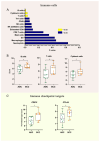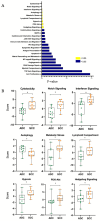Unraveling Differences in Molecular Mechanisms and Immunological Contrasts between Squamous Cell Carcinoma and Adenocarcinoma of the Cervix
- PMID: 38892393
- PMCID: PMC11172577
- DOI: 10.3390/ijms25116205
Unraveling Differences in Molecular Mechanisms and Immunological Contrasts between Squamous Cell Carcinoma and Adenocarcinoma of the Cervix
Abstract
This study aims to refine our understanding of the inherent heterogeneity in cervical cancer by exploring differential gene expression profiles, immune cell infiltration dynamics, and implicated signaling pathways in the two predominant histological types of cervix carcinoma, Squamous Cell Carcinoma (SCC) and Adenocarcinoma (ADC). Targeted gene expression data that were previously generated from samples of primary cervical cancer were re-analyzed. The samples were grouped based on their histopathology, comparing SCC to ADC. Each tumor in the study was confirmed to be high risk human papilloma virus (hrHPV) positive. A total of 21 cervical cancer samples were included, with 11 cases of SCC and 10 of ADC. Data analysis revealed a total of 26 differentially expressed genes, with 19 genes being overexpressed in SCC compared to ADC (Benjamini-Hochberg (BH)-adjusted p-value < 0.05). Importantly, the immune checkpoint markers CD274 and CTLA4 demonstrated significantly higher expression in SCC compared to ADC. In addition, SCC showed a higher infiltration of immune cells, including B and T cells, and cytotoxic cells. Higher activation of a variety of pathways was found in SCC samples including cytotoxicity, interferon signaling, metabolic stress, lymphoid compartment, hypoxia, PI3k-AKT, hedgehog signaling and Notch signaling pathways. Our findings show distinctive gene expression patterns, signaling pathway activations, and trends in immune cell infiltration between SCC and ADC in cervical cancer. This study underscores the heterogeneity within primary cervical cancer, emphasizing the potential benefits of subdividing these tumours based on histological and molecular differences.
Keywords: adenocarcinoma; cervical cancer; immune cells; squamous cell carcinoma; targeted gene expression profiling.
Conflict of interest statement
The authors declare no conflicts of interest.
Figures




Similar articles
-
The differences in immune features and genomic profiling between squamous cell carcinoma and adenocarcinoma - A multi-center study in Chinese patients with uterine cervical cancer.Gynecol Oncol. 2023 Aug;175:133-141. doi: 10.1016/j.ygyno.2023.05.071. Epub 2023 Jun 23. Gynecol Oncol. 2023. PMID: 37356314
-
Lung Adenocarcinoma and Squamous Cell Carcinoma Gene Expression Subtypes Demonstrate Significant Differences in Tumor Immune Landscape.J Thorac Oncol. 2017 Jun;12(6):943-953. doi: 10.1016/j.jtho.2017.03.010. Epub 2017 Mar 21. J Thorac Oncol. 2017. PMID: 28341226 Free PMC article.
-
Single-cell profiling reveals the intratumor heterogeneity and immunosuppressive microenvironment in cervical adenocarcinoma.Elife. 2025 Mar 11;13:RP97335. doi: 10.7554/eLife.97335. Elife. 2025. PMID: 40066698 Free PMC article.
-
Factors regulating SCC antigen expression in squamous cell carcinoma of the uterine cervix.Tumour Biol. 1998;19(6):494-504. doi: 10.1159/000030043. Tumour Biol. 1998. PMID: 9817979 Review.
-
Cervical adenocarcinoma: moving towards better prevention.Vaccine. 2011 Nov 15;29(49):9148-58. doi: 10.1016/j.vaccine.2011.09.115. Epub 2011 Oct 6. Vaccine. 2011. PMID: 21983356 Review.
Cited by
-
The immunological heterogeneity of squamous cell carcinoma and adenocarcinoma of the uterine cervix: a systematic review.Tumour Virus Res. 2025 Jul 9;20:200323. doi: 10.1016/j.tvr.2025.200323. Online ahead of print. Tumour Virus Res. 2025. PMID: 40639721 Free PMC article. Review.
References
-
- de Geus V., Ewing-Graham P.C., de Koning W., de Koning M.N.C., Bosch T.P.P.v.D., Nigg A.L., van Eijck C.H.J., Jozwiak M., van Beekhuizen H.J., Mustafa D.A.M. Identifying molecular changes in early cervical cancer samples of patients that developed metastasis. Front. Oncol. 2022;11:715077. doi: 10.3389/fonc.2021.715077. - DOI - PMC - PubMed
MeSH terms
Substances
Grants and funding
LinkOut - more resources
Full Text Sources
Medical
Molecular Biology Databases
Research Materials

